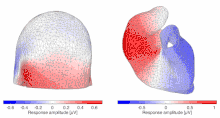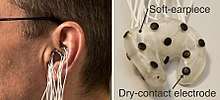Ear-EEG

Ear-EEG is a method for measuring dynamics of brain activity through the minute voltage changes observable on the skin, typically by placing electrodes on the scalp. In ear-EEG, the electrodes are exclusively placed in or around the outer ear, resulting in both a much greater invisibility and wearer mobility compared to full scalp electroencephalography (EEG), but also significantly reduced signal amplitude, as well as reduction in the number of brain regions in which activity can be measured. It may broadly be partitioned into two groups: those using electrode positions exclusively within the concha and ear canal, and those also placing electrodes close to the ear, usually hidden behind the ear lobe. Generally speaking, the first type will be the most invisible, but also offer the most challenging (noisy) signal. Ear-EEG is a good candidate for inclusion in a hearable device, however, due to the high complexity of ear-EEG sensors, this has not yet been done.
History
Ear-EEG was first described in "A1 US patent US20070112277 A1",[1] though other noteworthy mentions are "B1 EP patent EP2448477 B1"[2] and "Auditory evoked responses from Ear-EEG recordings".[3] Since then, it has grown to be an endeavor spread across multiple research groups[4] and collaborations, as well as private companies [5] .[6] Notable incarnations of the technology are the cEEGrid [7][8] (see picture to the right) and the custom 3D-printed ear plugs from NeuroTechnology Lab (see picture above). Attempts at creating in-ear generic earpieces are also known to be under way.[9][10][11][12][13]

Uses in research
It is possible to think of multiple research areas in which an unobtrusive and invisible EEG system would be beneficial.[14] Good examples are in studies of group dynamics or didactics, in which cases it would be very valuable to be able to monitor the effect of various events on individuals, while still letting them experience said events unfettered. And in this context, it is very important to perform detailed comparisons between ear-EEG and regular scalp EEG, as results need to be comparable across platforms. This has been done in multiple papers.[7][15][16][17] e In these it has been found that ear-EEG measurements are comparable to scalp EEG in the frequency domain; however, the time domain activity recorded by the two systems are notably different.
Dry-contact electrode ear-EEG
Dry-contact electrode ear-EEG is a method in which no gel is applied between the electrode and the skin.[18] This method generally improves the comfort and user-friendliness for long-term and real-life recordings. Because no gel is applied to the electrodes, the user can potentially mount the ear-EEG device without assistance.

Dry-contact electrode ear-EEG have been used to perform high-density ear-EEG recordings, which enable mapping of the brain response on a topographic 3D map of the ear (Ear-topographies).[19]
When using dry-contact electrodes, the interface between the skin and the electrodes are mainly defined by the electrochemical properties of the electrode material, the mechanical design of the electrode, the surface properties of the electrode, and how the electrode is retained against the skin. To improve these aspects for ear-EEG, nanostructured electrodes and soft earpieces have been proposed.[18] The electronic instrumentation must also be carefully designed to accommodate dry-contact electrodes.[21][22]
Real-life monitoring
The state of the human brain is influenced by the surrounding environment, and the response from the brain is influenced by the state of the brain. Thus, restricting brain research to a laboratory represents a fundamental limitation. Real-life EEG monitoring overcome this limitation, and enable research of evoked responses and spontaneous responses related to everyday life situations.
The compact and discreet nature of ear-EEG devices makes it suitable for real-life EEG monitoring.[23][24][25] A general problem when recordings EEG is the interference arising from noise and artifacts. In a laboratory environment, artifacts and interference can largely be avoided or controlled, in real-life this is challenging. Physiological artifacts are a category of artifacts with physiological origin, in contrast to artifacts arising from electrical interference. A study of physiological artifacts in ear-EEG found artifacts from jaw muscle contractions to be higher for ear-EEG compared to the scalp EEG, whereas eye-blinking did not influence the ear-EEG.[26][27]
Sleep monitoring
A promising use case is in long term sleep monitoring, where there is presently a need for a more user friendly (and cheaper) alternative to the gold standard polysomnography.[28][29] Innovation Fund Denmark recently funded a large project on using ear-EEG for sleep monitoring, in a collaboration between industry and Aarhus University in Denmark ,[30] however, development of an ear-EEG based sleep monitor is a global endeavor, with other prominent examples taking place at the University of Colorado ,[31] Imperial College London [32][17] as well as the University of Oxford.
Possible commercial uses
Despite the lack of ear-EEG products on the market, several companies have revealed investments in ear-EEG technology. Foremost of these are the hearing aid producers Oticon [33] and Widex,[34] who are looking into hearing-aid applications, the feasibility of which there appears to be some support for,[35][36] and a hypoglycemia alarm.
Other potential use cases which are known to have been explored are driver drowsiness detection,[37] BCI[38][39] and biometric identification.[40]
References
- ↑ A1 US patent US20070112277 A1
- ↑ B1 EP patent EP2448477 B1
- ↑ Kidmose, Preben. Auditory evoked responses from Ear-EEG recordings. EMBC 2012. San Diego, Cal.
- ↑ Bleichner, Martin (6 April 2015). "Exploring miniaturized EEG electrodes for brain-computer interfaces. An EEG you do not see?". Physiol Rep. 3. doi:10.14814/phy2.12362. PMC 4425967. PMID 25847919.
- ↑ "The Aware". United Sciences. Retrieved 25 August 2016.
- ↑ Fiedler, Lorenz. Ear-EEG Allows Extraction of Neural Responses in Challenging Listening Scenarios – A Future Technology for Hearing Aids?. EMBC 2016. Orlando, Fl.
- 1 2 Debener, Stefan (17 November 2015). "Unobtrusive ambulatory EEG using a smartphone and flexible printed electrodes around the ear". Scientific Reports. 5: 16743. doi:10.1038/srep16743. PMC 4648079. PMID 26572314.
- ↑ "cEEGrid –". www.ceegrid.com. Retrieved 2016-11-14.
- ↑ Kidmose, P.; Looney, D.; Jochumsen, L.; Mandic, D. P. (July 2013). "Ear-EEG from generic earpieces: A feasibility study". 2013 35th Annual International Conference of the IEEE Engineering in Medicine and Biology Society (EMBC). IEEE. doi:10.1109/embc.2013.6609557. ISBN 9781457702167.
- ↑ Dong, Hao. A New Soft Material based In-The-Ear EEG Recording Technique. EMBC 2016. Orlando, Fl.
- ↑ Goverdovsky, Valentin. Generic Viscoelastic In-Ear EEG Monitor. EMBC 2016. Orlando, Fl.
- ↑ Goverdovsky, Valentin (1 January 2016). "In-Ear EEG From Viscoelastic Generic Earpieces: Robust and Unobtrusive 24/7 Monitoring". IEEE Sensors Journal. IEEE. 16 (1): 271–277. doi:10.1109/JSEN.2015.2471183.
- ↑ Norton, James (31 March 2015). "Soft, curved electrode systems capable of integration on the auricle as a persistent brain–computer interface". PNAS. 112 (13): 3920–3925. doi:10.1073/pnas.1424875112. PMC 4386388. PMID 25775550.
- ↑ Casson, Alexander (10 May 2010). "Wearable electroencephalography. What is it, why is it needed, and what does it entail?". IEEE Engineering in Medicine and Biology Magazine. 29 (3): 44–56. doi:10.1109/MEMB.2010.936545.
- ↑ Mikkelsen, Kaare (18 November 2015). "EEG Recorded from the Ear: Characterizing the Ear-EEG Method". Frontiers in Neuroscience. 9: 438. doi:10.3389/fnins.2015.00438.
- ↑ Bleichner, Martin (5 October 2016). "Identifying auditory attention with ear-EEG: cEEGrid versus high-density cap-EEG comparison". Journal of Neural Engineering. 13 (6): 066004. doi:10.1088/1741-2560/13/6/066004.
- 1 2 Dong, Hao (18 October 2016). "A New Soft Material Based In-the-Ear EEG Recording Technique". Engineering in Medicine and Biology Society (EMBC) 2016.
- 1 2 3 Kappel, Simon L.; Rank, Mike Lind; Toft, Hans Olaf; Andersen, Mikael; Kidmose, Preben (2018). "Dry-Contact Electrode Ear-EEG". IEEE Transactions on Biomedical Engineering. doi:10.1109/tbme.2018.2835778. ISSN 0018-9294.
- 1 2 Kappel, Simon L.; Kidmose, Preben (July 2017). "High-density ear-EEG". 2017 39th Annual International Conference of the IEEE Engineering in Medicine and Biology Society (EMBC). IEEE. doi:10.1109/embc.2017.8037338. ISBN 9781509028092.
- ↑ Kappel, Simon L.; Kidmose, Preben (July 2017). "High-density ear-EEG". 2017 39th Annual International Conference of the IEEE Engineering in Medicine and Biology Society (EMBC). IEEE. doi:10.1109/embc.2017.8037338. ISBN 9781509028092.
- ↑ Kappel, Simon L.; Kidmose, Preben (August 2015). "Study of impedance spectra for dry and wet EarEEG electrodes". 2015 37th Annual International Conference of the IEEE Engineering in Medicine and Biology Society (EMBC). IEEE. doi:10.1109/embc.2015.7319063. ISBN 9781424492718.
- ↑ Xiong Zhou; Qiang Li; Kilsgaard, Søren; Moradi, Farshad; Kappel, Simon L.; Kidmose, Preben (June 2016). "A wearable ear-EEG recording system based on dry-contact active electrodes". 2016 IEEE Symposium on VLSI Circuits (VLSI-Circuits). IEEE. doi:10.1109/vlsic.2016.7573559. ISBN 9781509006359.
- ↑ Kappel, Simon L. (September 2016). Development and Characterization of Ear-EEG for Real-Life Brain-Monitoring (Ph.D. thesis). Aarhus University. doi:10.7146/aul.260.183.
- ↑ Bleichner, Martin G.; Lundbeck, Micha; Selisky, Matthias; Minow, Falk; Jäger, Manuela; Emkes, Reiner; Debener, Stefan; De Vos, Maarten (April 2015). "Exploring miniaturized EEG electrodes for brain-computer interfaces. An EEG you do not see?". Physiological Reports. 3 (4): e12362. doi:10.14814/phy2.12362. ISSN 2051-817X. PMC 4425967. PMID 25847919.
- ↑ Hoon Lee, Joong; Min Lee, Seung; Jin Byeon, Hang; Sook Hong, Joung; Suk Park, Kwang; Lee, Sang-Hoon (August 2014). "CNT/PDMS-based canal-typed ear electrodes for inconspicuous EEG recording". Journal of Neural Engineering. 11 (4): 046014. doi:10.1088/1741-2560/11/4/046014. ISSN 1741-2552. PMID 24963747.
- ↑ Kappel, Simon L.; Looney, David; Mandic, Danilo P.; Kidmose, Preben (2017-08-11). "Physiological artifacts in scalp EEG and ear-EEG". BioMedical Engineering OnLine. 16: 103. doi:10.1186/s12938-017-0391-2. ISSN 1475-925X. PMC 5553928. PMID 28800744.
- ↑ Kappel, Simon L.; Looney, David; Mandic, Danilo P.; Kidmose, Preben (August 2014). "A method for quantitative assessment of artifacts in EEG, and an empirical study of artifacts". 2014 36th Annual International Conference of the IEEE Engineering in Medicine and Biology Society. IEEE. doi:10.1109/embc.2014.6943931. ISBN 9781424479290.
- ↑ Stochholm, Andreas. Automatic Sleep Stage Classification using Ear-EEG. EMBC 2016. Orlando, Fl.
- ↑ Mikkelsen, Kaare. "Automatic sleep staging using ear-EEG". Biomedical engineering online. 16 (1): 111. doi:10.1186/s12938-017-0400-5.
- ↑ "Øreprop skal aflæse søvnløses hjerneaktivitet". Innnovation Fund Denmark. Retrieved 4 January 2018.
- ↑ Nguyen, Anh. A Lightweight and Inexpensive In-ear Sensing System For Automatic Whole-night Sleep Stage Monitoring. 14th ACM Conference on Embedded Network Sensor System. Stanford, USA.
- ↑ Moss, James (2017). "The Efficacy of In-Ear Electroencephalography (EEG) to Monitor Sleep Latency and the Impact of Sleep Deprivation". A80-C. NOVEL DIAGNOSTIC APPROACHES TO SDB.
- ↑ Fiedler, Lorenz. Around-the-Ear EEG Reflects the Attended Speaker in Multi-Speaker Scenario. EMBC 2016. Orlando, Fl.
- ↑ "Ear EEG-based Hypoglycaemia Alarm". Aarhus University. Retrieved 31 August 2016.
- ↑ Mirkovic, Bojana (27 July 2016). "Target Speaker Detection with Concealed EEG Around the Ear". Frontiers in Neuroscience. 9: 438. doi:10.3389/fnins.2015.00438.
- ↑ Mirkovic, Bojana. Ear-EEG Allows Extraction of Neural Responses in Challenging Listening Scenarios – A Future Technology for Hearing Aids?. EMBC 2016. Orlando, Fl.
- ↑ Hwang, Taeho. Driver Drowsiness Detection using the In-Ear EEG. EMBC 2016. Orlando, Fl.
- ↑ Choi, Soo-In. Feasibility of using Ear EEG for Developing a Practical Brain-Computer Interface System: A Preliminary Study. EMBC 2016. Orlando, Fl.
- ↑ Yu-Te Wang; Nakanishi, Masaki; Kappel, Simon Lind; Kidmose, Preben; Mandic, Danilo P.; Yijun Wang; Chung-Kuan Cheng; Tzyy-Ping Jung (August 2015). "Developing an online steady-state visual evoked potential-based brain-computer interface system using EarEEG". 2015 37th Annual International Conference of the IEEE Engineering in Medicine and Biology Society (EMBC). IEEE. doi:10.1109/embc.2015.7318845. ISBN 9781424492718.
- ↑ Yang, Jong-Kai. Passthoughts Authentication with Low Cost EarEEG. EMBC 2016. Orlando, Fl.
